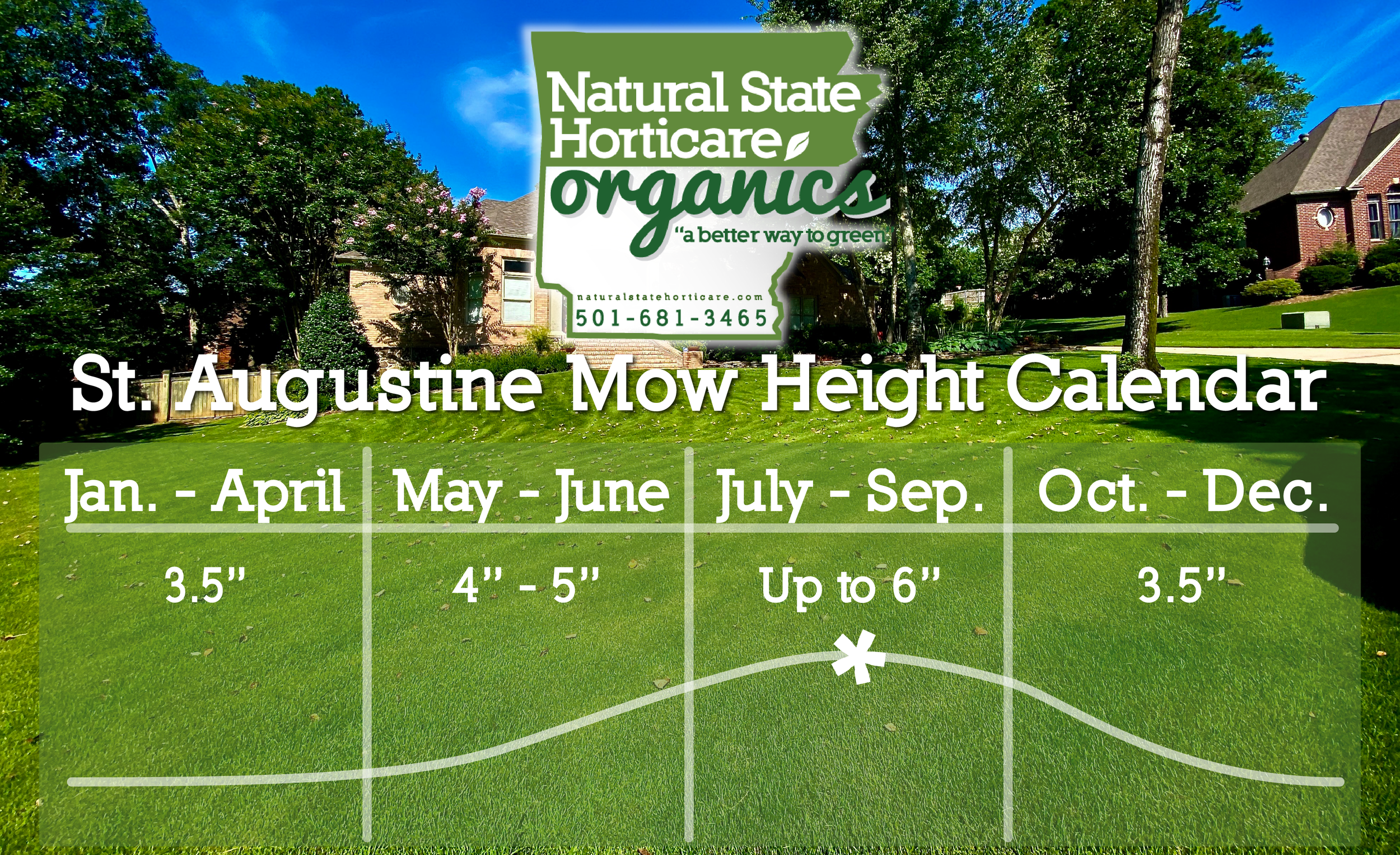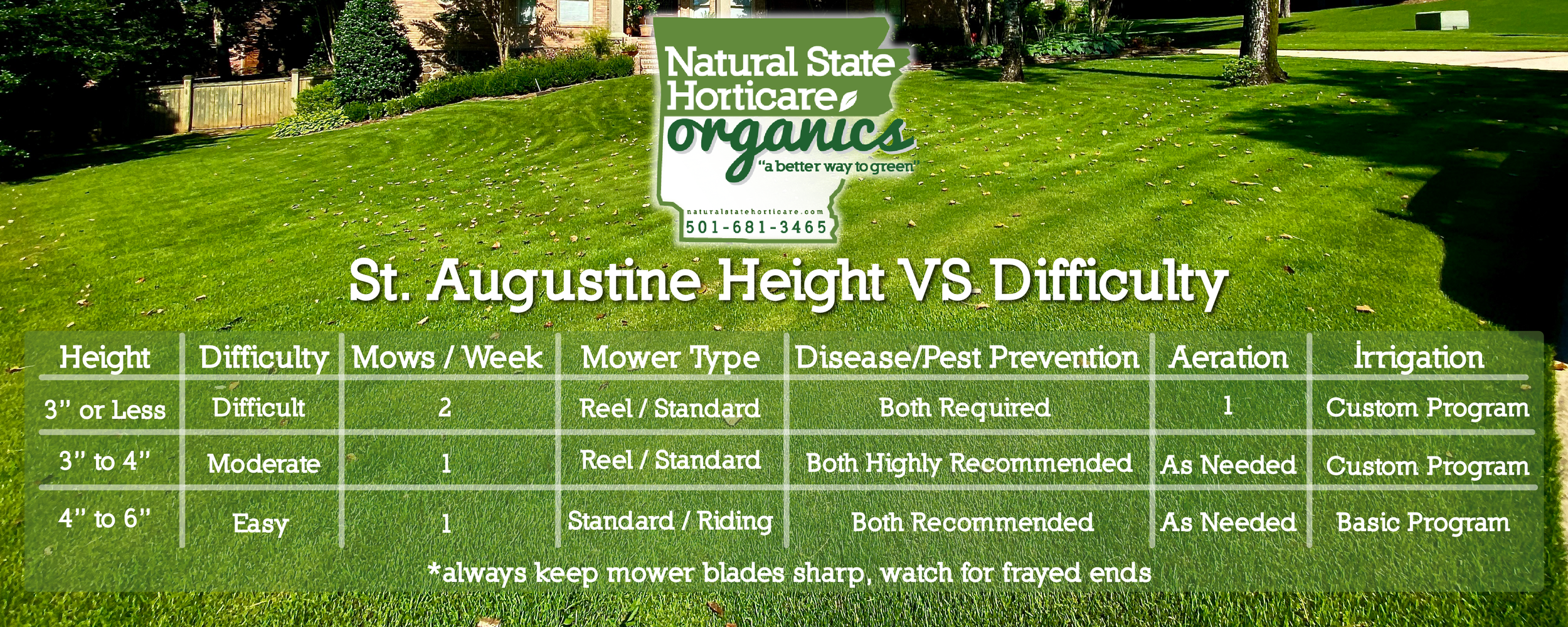St. Augustine Guide
A Complete Guide for Central Arkansas
St. Augustine grass is a popular warm-season turfgrass known for its lush, carpet-like appearance and ability to thrive in warm, humid climates. While it’s commonly found in coastal regions and the southern U.S., its use in Central Arkansas comes with unique challenges. Understanding its specific care requirements—mowing, watering, shade tolerance, and disease susceptibility—is crucial for keeping a healthy lawn.
In this guide, we’ll cover everything you need to know about St. Augustine grass in Central Arkansas, including its benefits, drawbacks, and whether it’s the right choice for your lawn.
Pros & Cons of St. Augustine Grass in Central Arkansas
Like any grass type, St. Augustine has advantages and drawbacks—especially in a challenging transition zone like Central Arkansas.
✅ Pros of St. Augustine Grass
✔ Best shade-tolerant warm-season grass – Great for yards with partial shade
✔ Thick, dense growth – Helps choke out weeds better than Bermuda or Zoysia
✔ Grows quickly – Establishes faster than Zoysia (but slower than Bermuda)
❌ Cons of St. Augustine Grass
🚫 NOT cold-hardy – Can suffer winter damage or thinning in harsh winters
🚫 NOT drought-resistant – Requires consistent watering compared to Bermuda/Zoysia
🚫 Prone to fungal diseases – Susceptible to large patch, take-all root rot, and gray leaf spot
🚫 Doesn’t recover well from damage – Unlike Bermuda, St. Augustine does not self-repair quickly
🚫 High maintenance – Needs frequent mowing, disease control, and irrigation management
💡 Best for: Homeowners with shaded lawns who are willing to commit to consistent maintenance.
Watering St. Augustine Grass
St. Augustine is not as drought-tolerant as Bermuda or Zoysia, requiring consistent moisture.
How Much Water Does St. Augustine Need?
1 to 1.5 inches per week, including rainfall
We recommend short cycles run more often (always in the morning).
For Example: 5-7 days per week for 10 min per cycle.
Unlike most warm-season grasses, the "deep & infrequent" method is NOT recommended for St. Augustine. It has extremely shallow roots, so watering "deep" (long run times) is pointless.
Increase watering during extreme summer heat to prevent drought stress
Signs of Under-watering:
🚨 Wilting or folding grass blades
🚨 A bluish-gray color instead of bright green
🚨 Footprints remain visible after walking on the grass
Signs of Overwatering:
🚨 Mushy or spongy soil
🚨 Increase in weeds like nutsedge or moss
🚨 Higher risk of fungal diseases
💡 Tip: Water early in the morning (before 10 AM) to prevent excessive evaporation and reduce the risk of fungal disease.
Shade Tolerance of St. Augustine Grass
One of the main reasons people choose St. Augustine over Bermuda or Zoysia is its superior shade tolerance. However, it still requires a minimum of 4 hours of direct sunlight daily to thrive. Learn More About Tree Trimming
Thrives In:
✔ Partially shaded areas (filtered sunlight)
✔ Lawns with scattered tree coverage
Struggles In:
🚫 Dense shade with less than 4 hours of sunlight
🚫 Areas heavily shaded by buildings or thick tree canopies
💡 Tip: Raise your mowing height in shady areas (4 - 6 inches) to help maximize photosynthesis.
Disease Susceptibility in St. Augustine Grass
St. Augustine is highly prone to fungal diseases, particularly in warm, humid climates like Central Arkansas. Here are some of the most common issues:
1. Large Patch 🍂
Symptoms: Circular brown patches with yellowish rings
Causes: Overwatering, excessive nitrogen, cool and wet conditions
Prevention: Avoid evening watering, improve air circulation, and apply a preventative fungicide
2. Gray Leaf Spot 🌱
Symptoms: Small gray or tan spots on the blades
Causes: Hot, humid weather, overwatering, and excessive nitrogen
Prevention: Reduce watering frequency, use balanced fertilizers
3. Take-All Root Rot (TARR) ⚠️
Symptoms: Yellowing grass that becomes thin and weak
Causes: Poor drainage, excessive moisture, and compacted soil
Prevention: Improve soil aeration, apply fungicide if needed
💡 Tip: Fungal problems are more common in shady, overwatered, or over-fertilized lawns. Proper lawn care practices significantly reduce disease risks.
Mowing St. Augustine Grass
Proper mowing is essential to maintaining a thick, healthy St. Augustine lawn. Unlike Bermuda or Zoysia, St. Augustine grass has a coarser blade and should be mowed at a higher height.
Ideal Mowing Height:
4 – 6 inches (standard recommendation)
Up to 6 inches in shady areas to maximize photosynthesis
Never cut more than ⅓ of the blade at once to prevent stress
Mowing Frequency:
Spring through summer: Once per week during peak growth
Fall: Every 10-14 days as growth slows
Winter (dormancy): St. Augustine may go semi-dormant but should NOT be scalped
💡 Tip: Always keep your mower blades sharp! Dull blades tear grass, making it more susceptible to disease and drought stress.





